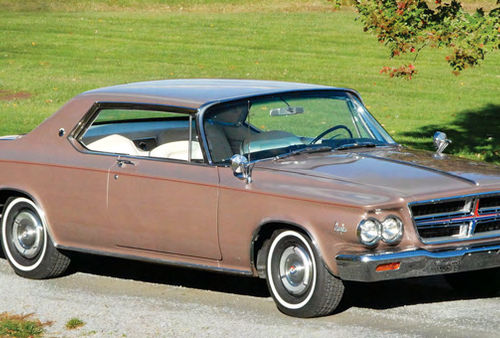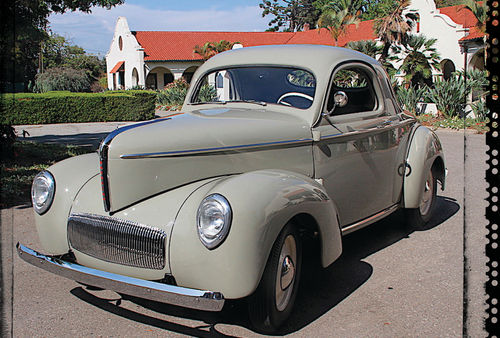1954 Packard Caribbean
If you're looking for an easy restoration project, a Packard Caribbean probably wouldn’t be your first choice. Only 400 were built in 1954 and each one involved a lot of custom hand work and special trim pieces. The Caribbean is not the sort of car where you just pick up the phone and order a new rear fender from Packards ‘R’ Us. Even though Gary Thomas had purchased an essentially complete car, he knew about most of the restoration obstacles that awaited him.
Packard introduced the Caribbean in 1953 as a production dream car to entice customers into the showrooms. Each car began life as an unpainted standard convertible. They were then shipped to the Ionia Manufacturing Co. for custom bodywork and finishing. Customizing features included lengthening the rear fenders, reshaping the hood, scooping out the rear wheel-wells to fully expose the wheels, and adding a continental kit.

Custom-made Trouble
All that custom work means headaches for the restorer. Thomas says, “A lot of lead was necessary. It was used with the extra sheetmetal to lengthen the rear fenders. (You can see how this was done by looking inside the trunk, where it is common to see this panel loose or buckled.) Lead was also used extensively in the creation of the distinctive scooped hood. An original hood probably weighs. about 300 pounds. Some fake fiberglass hoods have been spotted.”
“Over half of the chrome on this car is unique to the 1954 Caribbean. The hood and continental kit are also 1954-Caribbean-only items. The chrome was expensive to restore because the grille collar was one piece and a large amount of die cast pot metal was used in the car. The wire wheels get rusty and are expensive to re-plate and rebuild (about $500 per wheel). It took eight years to do all of the chrome.”
The trunk lids leaked water and frequently caused the trunk floors to rust. The rockers and rear fenders are also prone to rust. Thomas says Packard’s rear fenders were built with outer and inner panels. The unsealed air space in between trapped dirt and moisture, causing the fenders to rust from the inside out.

The Caribbean came equipped with all the luxury power assists available at the time: brakes, steering, adjustable seat, windows and top. The latter two used the infamous Duro electric/hydraulic system shared with Cadillac, Hudson and others. Switches activated a control valve and an electric motor and pump under the hood. This pump pushed brake fluid through a network of hoses and metal lines to cylinders that hydraulically activated the top and windows.
Moisture absorbed by the brake fluid eventually caused leaks in the cylinders, the pump, the control valve and the lines. Thomas says fluid leaks often ruined the paint at the bottom of the doors and on the rocker panels. (See the “Hydro-Lectric Power” article on power-window repair in CAR June 1996.) He also notes that hydraulic lines run next to the electrical wiring. Leaking brake fluid could melt the insulation on the wires, sometimes causing fires.
The 1954 Caribbean used a 359cubic-inch version of Packard’s respected nine-main-bearing straight eight. However, to tweak output to 212 horsepower, engineers raised the compression to 8.7:1, very high for a flathead design. For faster heat dissipation and to reduce pinging, they cast an aluminum cylinder head unique to senior-series 1954 Packards with the 359 engine.
A Packard in the Closet
Thomas had wanted a Caribbean since 1973, when he’d seen one while buying a 1936 Packard 120. Three years later he found another, and this time it took 10 years to persuade the owner to sell it.

Thomas says, “The paint was cracked and flaking off; rust was eating away the metal. His first pictures make the car “look better than it was.” The Caribbean had 42,183 miles on it and wasn’t running. The engine, fuel system, brakes, transmission and rear end all needed work before the car could be driven.
The Ultramatic transmission was rebuilt even though it seemed to work properly. Ultramatic was the only automatic designed in-house by an independent automaker (Studebaker’s unit came from Borg-Warner), and Thomas wanted to head off any problems before any hard-to find parts were damaged or broken. Hydraulic pressure is critical to the operation of the transmission, he says, so “when you rebuild them you should replace all those bushings. The Ultramatic rebuild kits don’t always come with all the parts you need.” (Clutches, gaskets and O-rings are in the kits. Bushings and any other worn parts have to come from other parts suppliers that carry Packard parts.)
This Caribbean went on short tours for a few years before any serious restoration started. Thomas says “this gave us time to check out the condition of the car and find the necessary parts to start a complete restoration. In the fall of 1990, we started taking the car apart.”
Thomas credits his wife Terry and son Scott with much of the work. Terry wrote letters looking for parts, took hundreds of photos to document the restoration, and helped paint and detail small parts like the hubcaps. Scott, who was 20 at the time, was assigned to sandblast the bottom of the car and undercoat it.
As the car was disassembled over the course of three years, Thomas had a friend paint each panel. Acrylic urethane in the original Sahara Sand and black paint scheme was used.
Thomas says, “I had the doors, front fenders, trunk and hood each painted separately before doing the main body. I did this to spend time on each part to get the quality that I wanted on the paint job. I was able to clean and prepare each part myself. After all the removable parts were painted, the rest of the car was taken to my friend’s garage and he finished the body work and painting.
"I was very pleased with the results of doing it this way.”
“We put parts in all different areas of the house, wrapped them in sheets and blankets,” Thomas says. “We didn’t cover them too tight at first so the paint could dry. It takes at least a month for it to get really hard. The doors and trunk were stored in the extra bedroom. Fenders went in the basement and the hood went in Scott’s extra bedroom closet along with the re-chromed parts. I’m sure Terry thought the car was never go ing to be finished and that she would have car parts as furniture forever.” One area Thomas left untouched was the side of the glove compartment drawer. The original paint here was in good condition anyway, and he wanted to leave the original paper tags with paint codes in place.
Fender Bender
Those unique double-walled, custom-stretched rear fenders on the Caribbean presented a special challenge. Thomas says that once the paint was stripped off, “You could tell that one side of the car was done by one person and the other side was done by another. The left side was done by someone who took special care; the right side we had to do a lot more work. The lead was buckled, and the original workmanship was not up to modern car-show standards. My body man had to take care of that.”

Because of the double-walled fender construction, Thomas warns that the extent of rust is hard to evaluate by sight. He says, “It’s a rust trap. If there’s a hole the size of your little finger showing, you might end up with a hole three inches in diameter. If you find a hole in one side, you'll probably find one on the other. We ran into pinholes. We ended up having to cut out big patches to get to where the metal was thick again.”

In most places where rust was visible on one wall of the fender, both walls had to be patched. This made welding from both sides necessary.
Make What You Need
The scarcity of Packard parts is an obstacle restorers must work around. Companies like Kanter Auto Products make some mechanical components like fuel pumps, but Thomas found new-old-stock mechanical and body parts hard to find. “There are many 1954 Packards still being driven and because parts are not being made, there is competition for what exists.” The aluminum heads and some of the transmission parts unique to 1954 are among the most difficult-to-find items.

Consequently, Thomas turned to experts to make many items for his restoration. For instance, he says “I could not find an original 1954 Caribbean steering wheel, gear shift and turn-signal knobs. Packard cast a white color only for the Caribbeans in 1954. I broke a piece of my original wheel to see the original color inside of the plastic. I sent my steering wheel, turn-signal arm and gearshift knob and plastic sample to Troosh. Troosh did an excellent job matching the color and casting. The parts look like they came from the factory.” He says it cost $450 to have the steering wheel, turn-signal indicator and shift knob cast by Troosh.
The original vinyl and leather interior was in poor condition, but could be used as a pattern. Thomas hired a retired upholsterer to come to his garage and fabricate a new interior to match the original. Although the fellow didn’t consider it a rush job and took over two years to complete the task, he became a good friend and the results were worthwhile. Thomas also had him make a new top from stayfast Haartz cloth. The original Orlon top material was prone to leaks and is no longer manufactured.
OEM Glass sold Thomas a full set of new windows. The original windshield was delaminating and several other windows were cracked. Thomas says OEM cut the pieces using original patterns and even put the correct logo and dates on the windshield and side glass to match his original pieces.
The original gas tank was cleaned and tinned at a local shop. According to Thomas, “I wanted it tinned be cause some of the sealers available do not resist the new types of gas. This is as good as having a new tank, which is almost impossible to find for this car.”
Classic Tube manufactured a full set of brake, fuel and hydraulic lines in stainless steel using Thomas’s originals as patterns. Thomas says these lines have many tight bends that he couldn’t duplicate with a hand bender. Stainless cost only 15 percent more and Thomas wanted to avoid future problems with rust and corrosion. To further ensure trouble-free operation of the top and windows, Thomas turned to Precision Engineering to rebuild his pump, cylinders and control valve. He says, “They ... are comparable in price with other suppliers. All of their parts are designed to work with transmission fluid (which is less corrosive than brake fluid). When they rebuild a pump, it is better than original in performance and durability and has a 60-month warranty.”
Massive Project
Thomas and a machinist who worked on Packard engines in the ’50s rebuilt the block. The Caribbean’s motor and transmission together weigh an imposing 1011 pounds, far more than similar-size V-8s. The overall length is another factor to be reckoned with.

According to Thomas, “The engine is 38 inches, plus the transmission. It’s a long unit. Taking it out was scary. You have to be careful coming out because you don’t want to break any of the hard-to-find parts. We had no fenders on the car when we re-installed it and that made it a lot easier.”
The aluminum head in Thomas’s Caribbean wasn’t cracked, but someone had stripped the spark plug threads and inserted bushings. Thomas decided to replace it with another aluminum head, but ended up looking at 18 heads before finding One in good condition. Unfortunately, it was easy to strip the threads in the spark plug holes, and cracks sometimes developed around plugs two, six and seven. Not only are perfect heads difficult to find, but cracked heads are extremely difficult and expensive to repair. Thomas says cast iron heads from the 327cubic-inch engine will fit the bigger block, but these heads aren’t as tall so the automatic transmission’s downshift linkage must be adjusted where it mounts to the head. He says the aluminum head should be stamped with the number 359, indicating displacement, while the cast iron heads carry the number 327.
Tuning the engine after reinstalling it posed more challenges. The block’s great length means that the fuel/air mixture from the carburetor is distributed unevenly among the cylinders. Cooling is unbalanced; Thomas says there’s a 15-degree temperature difference between the front and back of the block.
Elec-trickery
The Caribbean electrical system was quite complicated because of all the power-operated accessories. Thomas chose to rewire the entire car because the original fabric-coated, plastic-coated and rubber-insulated wiring was brittle. In the process, he learned a few useful tricks.
Thomas took the dashboard off to paint it, then decided to wire it out of the car. Placing it on a table so he could work in a comfortable position, Thomas connected as much of the electrical spaghetti as possible. He labeled all the wires and then installed the assembled unit in the car, minimizing the amount of time he had to spend in a back-breaking position fumbling under the dash.
When Thomas installed the freshly rebuilt hydraulic motor and pump for the top and window mechanism, it ran very slowly. He tested for a bad ground by hooking a “jumper” from the pump’s bracket to the battery’s positive terminal (the Packard is positive ground). The pump ran normally. He removed the pump brackets and scraped off some paint to give them better contact. He also cleaned the battery grounding strap, and the problem was solved. Thomas adds, “Bad grounds on the light sockets will give you dim lights. If you have poor radio reception check the antenna ground; it might be bad.”
Another discovery Thomas made concerned the spark plug wires. He first bought a kit from NAPA to make his own. NAPA’s kit included modern resistor wire. According to Thomas, the extreme lengths necessary to reach the end cylinders meant “you couldn’t get a hot enough spark with it. The spark plugs wouldn’t burn right. In around town driving they’d carbon-up and you'd have a little bit of a mis-fire.”
Delco made the original Packard 440 solid copper wire, and Thomas says it is now back in production. He bought a 50-foot roll through a Delco parts dealer. Installing new non-resistor spark plug wires definitely improved the Caribbean’s performance, according to Thomas.
Trophy Magnet
All these efforts have paid off in a beautiful car the family is proud to take to shows. Thomas says, “I never expected the Caribbean to win so many awards. I just wanted a car that I could be proud of and enjoy driving on tours.”
Nonetheless, the Packard has accumulated quite a glittering shelfload since the restoration was finished. At the Packard Cuneo Show in September 1995, Thomas's Caribbean took home the People’s Choice Award for Post-War Packard. It earned its first junior at the huge Antique Automobile Club of America Detroit meet in 1996.
The highlight came at the 1996 Packard Club National in Dayton, Ohio. Thomas and his family drove the Caribbean to the show. It took first place in its class, the James Nance Award for Best Post-War Packard and the Wayne Merriman Award for best Packard restored by an individual or family.
The awards banquet was the night of Thomas’s 48th birthday. He says, “I can’t remember a more exciting birthday or better presents. It was especially nice sharing this with my family and all of my friends from Packards of Chicagoland.”
















